|
|
|
Sort Order |
|
|
|
Items / Page
|
|
|
|
|
|
|
| Srl | Item |
| 1 |
ID:
057286
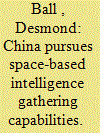

|
|
|
| 2 |
ID:
164113
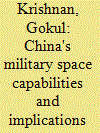

|
|
|
| 3 |
ID:
082539
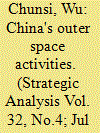

|
|
|
|
|
| Publication |
2008.
|
| Summary/Abstract |
One important feature of China's outer space policy is to carry out cooperation with all countries. In the cooperation, China pays great attention to the rights and demands of developing countries in the high-technology area. With more actors in outer space, it is necessary and urgent to improve the existing legal system regulating the relations of countries and non-state actors. China's attitude to outer space activities is driven by both domestic and international elements. Development, defence, and technological innovation are the three major goals of China's outer space programmes
|
|
|
|
|
|
|
|
|
|
|
|
|
|
|
|
| 4 |
ID:
082538
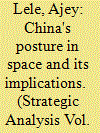

|
|
|
|
|
| Publication |
2008.
|
| Summary/Abstract |
As part of its peaceful rise strategy, China has made resolute investments in the field of science and technology. One major aspect of this technological quest has been its investments in space technologies. China's success in this field is remarkable and has brought glory to the nation. However, at the same time, the anti-satellite test (ASAT) undertaken by China, during January 2007, has raised the fears of the weaponization of space. This article examines the developments in China's space programme and attempts to analyse its impact on the global space architecture in general and on India in particular.
|
|
|
|
|
|
|
|
|
|
|
|
|
|
|
|
| 5 |
ID:
086599
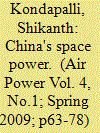

|
|
|
|
|
| Publication |
2009.
|
| Summary/Abstract |
Professor Srikanth Kondapalli has argued that "one of the motives behind the development in China's space programme, albeit generally not mentioned explicitly, is for military usage." China became the first country in the world to have tested explicitly a land-based missile to destroy a space-based object on January 11, 2007. This ASAT test has led to concerns in Asia, with objections raised by Taiwan, Japan, South Korea, India and by others such as the US, Russia and the EU countries. This has the potential to initiate a further arms race in space and contribute to the destabilisation trends.
|
|
|
|
|
|
|
|
|
|
|
|
|
|
|
|
| 6 |
ID:
072621
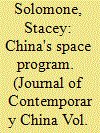

|
|
|
|
|
| Publication |
2006.
|
| Summary/Abstract |
Since China's great leap into space in late 2003 with their first taikonaut reaching orbit and safely returning to Earth, much attention has been given to the question regarding the future of China's space program. Concerns abound about the Chinese military's role in the space program but hope remains that China's space program will follow a path to a peaceful multilateral exploration of outer space. This paper looks at a possible future for the Chinese space program, one in which the People's Liberation Army (PLA) retains tight control over the direction of the program.
|
|
|
|
|
|
|
|
|
|
|
|
|
|
|
|
| 7 |
ID:
070945
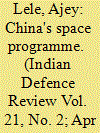

|
|
|
| 8 |
ID:
184879
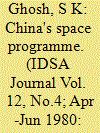

|
|
|
| 9 |
ID:
189998
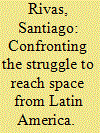

|
|
|
| 10 |
ID:
051620
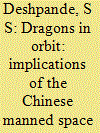

|
|
|
| 11 |
ID:
072003
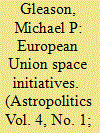

|
|
|
|
|
| Publication |
2006.
|
| Summary/Abstract |
The European Union (EU) is the newest actor in the European space sector and is cultivating the political will to make Europe a world class space power comparable to the United States (US). The Galileo satellite system and the Global Monitoring for the Environment and Security space program are the most visible manifestations of this will. This article suggests that Europe can approach comparable space power if capabilities are considered rather than just budgets. The paper discusses the catalysts driving EU space initiatives, and assesses the EU's nascent European Space Policy and European Space Program, and EU organization and funding for space. Of importance are the asymmetric means for Europe to increase its space capabilities and the implications this has for the trans-Atlantic relationship with the US. The analysis is directed to the security, civil, and dual-use space sectors within the security aspects of EU space initiatives. This article also provides a baseline to track changes in EU space policy, organization, and funding dynamics.
|
|
|
|
|
|
|
|
|
|
|
|
|
|
|
|
| 12 |
ID:
081554
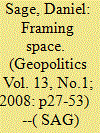

|
|
|
|
|
| Publication |
2008.
|
| Summary/Abstract |
This paper examines how 'ways of seeing' landscape, as practised within the little-known American astronomical art community, can be used to examine the popular geopolitical scripting of an American manifest destiny in outer space. A significant body of work in critical geopolitics has sought to recognise the way in which culturally manifest representations of space and place, together with embedded visual practices, can reproduce and elucidate the construction of geographical imaginations. Despite this, cultural representations of outer space have frequently been overlooked in readings of American popular, geopolitical discourse and associated geographical understandings. As a response to this lacuna, this paper interrogates how visual motifs of an American manifest destiny, developed in nineteenth-century American romanticism, have been mobilised through American astronomical art to explain and popularise conceptions of outer space that invite American human space exploration. By way of conclusion, the paper stresses how the inscription of outer space under the rubric of an American manifest destiny continues to frame the way in which the American space programme, and by extension American geopolitical and geographical imaginations, can be understood today
|
|
|
|
|
|
|
|
|
|
|
|
|
|
|
|
| 13 |
ID:
139177
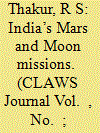

|
|
|
|
|
| Summary/Abstract |
The Moon and Mars have stirred the imagination of space scientists since ages because of their relative proximity to Earth, as compared with other heavenly bodies. The Moon, located at a distance of 38,000 km, is the heavenly body nearest to the Earth. It is natural that our satellite remained the object of the first research since the beginning of the Space Age. Mars, the fourth planet in the solar system after Earth, has a year of 687 days and a day which differs from the Earth-day by a little less than half an hour; it is smaller as well as lighter than the Earth and less dense too with its gravity just about 38 percent of the gravity on Earth. It has two satellites: Phobos and Deimos. Soon after the dawn of the Space Age in 1957, both the US and erstwhile USSR initiated numerous projects to carry out wide-sweeping reconnaissance of the solar system, including the Moon and Mars, during the 1960s and 1970s. This was followed by increasing European and Japanese activities in the area of interplanetary exploration in 1980.1 Since then, there has been an overall continuity in nations attempting interplanetary exploration. India, with its robust space programme, has been making steady progress in deep space exploration, along with other space-faring nations right from the beginning.
|
|
|
|
|
|
|
|
|
|
|
|
|
|
|
|
| 14 |
ID:
148411


|
|
|
|
|
| Publication |
Noida, HarperCollins Publishers, 2016.
|
| Description |
xi, 436p.hbk
|
| Standard Number |
9789351777519
|
|
|
|
|
|
|
|
|
|
|
|
Copies: C:1/I:0,R:0,Q:0
Circulation
| Accession# | Call# | Current Location | Status | Policy | Location |
| 058866 | 181.44/KAN 058866 | Main | On Shelf | General | |
|
|
|
|
| 15 |
ID:
143447
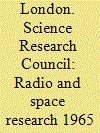

|
|
|
|
|
| Publication |
London, Her Majesty's Stationery Office, 1968.
|
| Description |
v, 37p.pbk
|
| Standard Number |
118803077
|
|
|
|
|
|
|
|
|
|
|
|
Copies: C:1/I:0,R:0,Q:0
Circulation
| Accession# | Call# | Current Location | Status | Policy | Location |
| 002530 | 537.534/LON 002530 | Main | On Shelf | General | |
|
|
|
|
| 16 |
ID:
074789
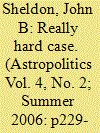

|
|
|
|
|
| Publication |
2006.
|
| Summary/Abstract |
On 27 October 2005, the first Iranian satellite-Sinah-1-was launched. The satellite failed soon after launch, but it represented a significant technological step by the Islamic Republic, and was also a statement of intent on behalf of Iranian space ambitions. Current and projected Iranian space capabilities are highly dependent upon foreign technologies and expertise, but the Iranian nuclear and ballistic missile programmes offer a glimpse of how Iran's space programme may yet develop. This essay provides an overview of Iranian space capabilities, and places it within contemporary Iranian domestic and strategic contexts. It also offers an insight into how Iran's space programme is organized, and lastly, offers a view on how best the United States might influence Iran's space programme.
|
|
|
|
|
|
|
|
|
|
|
|
|
|
|
|
| 17 |
ID:
087172
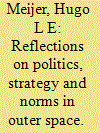

|
|
|
|
|
| Publication |
2009.
|
| Summary/Abstract |
This article focuses on the underestimated discrepancy between recent optimistic theoritical attempst aimed at providing US policymakers with a coherent astro strategy for space dominance, and the destabilizing consequences for international stability deriving from their implimentation.
|
|
|
|
|
|
|
|
|
|
|
|
|
|
|
|
| 18 |
ID:
120238
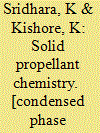

|
|
|
|
|
| Publication |
New Delhi, DRDO, 1999.
|
| Description |
x,235p.hbk
|
| Standard Number |
8186514026
|
|
|
|
|
|
|
|
|
|
|
|
Copies: C:1/I:0,R:0,Q:0
Circulation
| Accession# | Call# | Current Location | Status | Policy | Location |
| 057264 | 629.47524/SRI 057264 | Main | On Shelf | General | |
|
|
|
|
| 19 |
ID:
090157
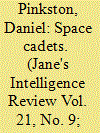

|
|
|
|
|
| Publication |
2009.
|
| Summary/Abstract |
For South Korea, it is better late than never, The country is finally nearing the launch of the Naro-1, or the Korea Space-Launch Vehicle (KSLV-1), from the newly built Naro Space Center. The launch follows delays that have hindered the project from the outset.On 2 June 2009, after four years of setbacks, South Korea's National Space Committee approved the launch proposal submitted by the Korea Aerospace Research Institute (KARI) for 30 July.
|
|
|
|
|
|
|
|
|
|
|
|
|
|
|
|
|
|
|
|
|